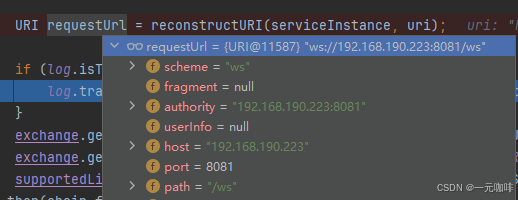SpringCloud Gateway默认不支持将请求路由到一个服务的多个端口
本文将结合Gateway的处理流程,提供一些解决思路
需求背景
公司有一个IM项目,对外暴露了两个端口8081和8082,8081是springboot启动使用的端口,对外提供一些http接口,如获取聊天群组成员列表等,相关配置如下
spring:
application:
name: im
server:
port: 8081
servlet:
context-path: /im
8082是内部启动了一个netty服务器,处理websocket请求,实现即时通讯
......
......
pipeline.addLast(new WebSocketServerProtocolHandler("/ws"));
......
......
bootstrap.bind(8082).sync();
以本地环境为例,直连IM项目的请求地址如下:
http://localhost:8081/im/*** (请求http接口)
ws://localhost:8082/ws(进行websocket协议升级)
项目组希望客户端能统一走网关,实现对这两种接口的调用
问题描述
网关使用springcloud gateway,监听端口8080,注册中心使用nacos
正常情况下,gateway根据服务名转发,配置如下
- id: im_route
uri: lb://im
predicates:
- Path=/im/**
访问网关http://localhost:8080/im/**,即可将请求转发到IM服务
同理,我们希望访问网关ws://localhost:8080/ws,也能转发到IM的netty服务器
一般情况下,如果要通过gateway转发websocket请求,我们需要做如下配置
- id: im_ws_route
uri: lb:ws://im
predicates:
- Path=/ws/**
但实际上,lb这个schema告诉gateway要走负载,gateway转发的时候,会到nacos拉取im的服务清单,将其替换为 ip + 端口,而nacos上注册的是springboot项目的端口,也就是8081,所以想转发到IM的8082上,默认是没办法利用gateway的服务发现机制的,只能直接配置服务的ip地址,如下
- id: im_ws_route
uri: ws://localhost:8082
predicates:
- Path=/ws
不过这样也就失去使用网关的意义了
寻找思路
先观察下gateway转发的流程,找到DispatcherHandler的handle方法
@Override
public Mono<Void> handle(ServerWebExchange exchange) {
if (this.handlerMappings == null) {
return createNotFoundError();
}
if (CorsUtils.isPreFlightRequest(exchange.getRequest())) {
return handlePreFlight(exchange);
}
return Flux.fromIterable(this.handlerMappings)
.concatMap(mapping -> mapping.getHandler(exchange))
.next()
.switchIfEmpty(createNotFoundError())
.onErrorResume(ex -> handleDispatchError(exchange, ex))
.flatMap(handler -> handleRequestWith(exchange, handler));
}
首先遍历内部的HandlerMapping,依次调用其getHandler方法,寻找能处理当前请求的Handler
HandlerMapping共有四个,一般来说我们配置了上述的路由,会在第三个RoutePredicateHandlerMapping返回一个Handler
Handler类型为FilteringWebHandler,其中包含了一组Filter
找到Handler后,在DispatcherHandler # handle方法的最后一行,调了handleRequestWith方法
private Mono<Void> handleRequestWith(ServerWebExchange exchange, Object handler) {
if (ObjectUtils.nullSafeEquals(exchange.getResponse().getStatusCode(), HttpStatus.FORBIDDEN)) {
return Mono.empty(); // CORS rejection
}
if (this.handlerAdapters != null) {
for (HandlerAdapter adapter : this.handlerAdapters) {
if (adapter.supports(handler)) {
return adapter.handle(exchange, handler)
.flatMap(result -> handleResult(exchange, result));
}
}
}
return Mono.error(new IllegalStateException("No HandlerAdapter: " + handler));
}
然后遍历了HandlerAdapter,一共有四个
这里起作用的是最后一个SimpleHandlerAdapter,进入其handle方法
@Override
public Mono<HandlerResult> handle(ServerWebExchange exchange, Object handler) {
WebHandler webHandler = (WebHandler) handler;
Mono<Void> mono = webHandler.handle(exchange);
return mono.then(Mono.empty());
}
调用了上面找到Handler的handle方法
@Override
public Mono<Void> handle(ServerWebExchange exchange) {
Route route = exchange.getRequiredAttribute(GATEWAY_ROUTE_ATTR);
List<GatewayFilter> gatewayFilters = route.getFilters();
List<GatewayFilter> combined = new ArrayList<>(this.globalFilters);
combined.addAll(gatewayFilters);
// TODO: needed or cached?
AnnotationAwareOrderComparator.sort(combined);
if (logger.isDebugEnabled()) {
logger.debug("Sorted gatewayFilterFactories: " + combined);
}
return new DefaultGatewayFilterChain(combined).filter(exchange);
}
最后filter方法依次执行了其中的Filter
@Override
public Mono<Void> filter(ServerWebExchange exchange) {
return Mono.defer(() -> {
if (this.index < filters.size()) {
GatewayFilter filter = filters.get(this.index);
DefaultGatewayFilterChain chain = new DefaultGatewayFilterChain(this, this.index + 1);
return filter.filter(exchange, chain);
}
else {
return Mono.empty(); // complete
}
});
}
}
在这些Filter中,有一个ReactiveLoadBalancerClientFilter,会完成从nacos拉取服务清单替换请求地址的任务
看下它的filter方法
@Override
public Mono<Void> filter(ServerWebExchange exchange, GatewayFilterChain chain) {
URI url = exchange.getAttribute(GATEWAY_REQUEST_URL_ATTR);
String schemePrefix = exchange.getAttribute(GATEWAY_SCHEME_PREFIX_ATTR);
if (url == null || (!"lb".equals(url.getScheme()) && !"lb".equals(schemePrefix))) {
return chain.filter(exchange);
}
// preserve the original url
addOriginalRequestUrl(exchange, url);
if (log.isTraceEnabled()) {
log.trace(ReactiveLoadBalancerClientFilter.class.getSimpleName() + " url before: " + url);
}
URI requestUri = exchange.getAttribute(GATEWAY_REQUEST_URL_ATTR);
String serviceId = requestUri.getHost();
Set<LoadBalancerLifecycle> supportedLifecycleProcessors = LoadBalancerLifecycleValidator
.getSupportedLifecycleProcessors(clientFactory.getInstances(serviceId, LoadBalancerLifecycle.class),
RequestDataContext.class, ResponseData.class, ServiceInstance.class);
DefaultRequest<RequestDataContext> lbRequest = new DefaultRequest<>(
new RequestDataContext(new RequestData(exchange.getRequest()), getHint(serviceId)));
return choose(lbRequest, serviceId, supportedLifecycleProcessors).doOnNext(response -> {
if (!response.hasServer()) {
supportedLifecycleProcessors.forEach(lifecycle -> lifecycle
.onComplete(new CompletionContext<>(CompletionContext.Status.DISCARD, lbRequest, response)));
throw NotFoundException.create(properties.isUse404(), "Unable to find instance for " + url.getHost());
}
ServiceInstance retrievedInstance = response.getServer();
URI uri = exchange.getRequest().getURI();
// if the `lb:<scheme>` mechanism was used, use `<scheme>` as the default,
// if the loadbalancer doesn't provide one.
String overrideScheme = retrievedInstance.isSecure() ? "https" : "http";
if (schemePrefix != null) {
overrideScheme = url.getScheme();
}
DelegatingServiceInstance serviceInstance = new DelegatingServiceInstance(retrievedInstance,
overrideScheme);
URI requestUrl = reconstructURI(serviceInstance, uri);
if (log.isTraceEnabled()) {
log.trace("LoadBalancerClientFilter url chosen: " + requestUrl);
}
exchange.getAttributes().put(GATEWAY_REQUEST_URL_ATTR, requestUrl);
exchange.getAttributes().put(GATEWAY_LOADBALANCER_RESPONSE_ATTR, response);
supportedLifecycleProcessors.forEach(lifecycle -> lifecycle.onStartRequest(lbRequest, response));
}).then(chain.filter(exchange))
.doOnError(throwable -> supportedLifecycleProcessors.forEach(lifecycle -> lifecycle
.onComplete(new CompletionContext<ResponseData, ServiceInstance, RequestDataContext>(
CompletionContext.Status.FAILED, throwable, lbRequest,
exchange.getAttribute(GATEWAY_LOADBALANCER_RESPONSE_ATTR)))))
.doOnSuccess(aVoid -> supportedLifecycleProcessors.forEach(lifecycle -> lifecycle
.onComplete(new CompletionContext<ResponseData, ServiceInstance, RequestDataContext>(
CompletionContext.Status.SUCCESS, lbRequest,
exchange.getAttribute(GATEWAY_LOADBALANCER_RESPONSE_ATTR),
new ResponseData(exchange.getResponse(), new RequestData(exchange.getRequest()))))));
}
首先判断uri配置了lb,需要根据服务名做负载转发
在这个filter前,已经根据请求路径/ws和router配置,将请求地址转换成了 服务名:请求路径的形式,也就是将ws://localhost:8080/ws转化成了ws://im/ws
然后根据服务名im到nacos获取到服务的实际地址
ServiceInstance retrievedInstance = response.getServer();
其中包含了ip和端口
最后替换出实际要转发的地址
所以我们只要在这一步,根据需要将端口8081改成8082,就能实现我们要的效果了
最终解决方案
最初是想自定义一个HandlerMapping完成转发的,但看下来后直接改源码更便捷一些,所以直接在项目中新建一个同路径的类,将源码copy进来,覆盖掉这个Filter
然后在获取到nacos实例后,修改掉端口号,就能改变最终的目标地址
在获取服务实例ServiceInstance retrievedInstance = response.getServer()这行后面加一段代码
if (url.toString().equals("ws://im/ws")) {
try {
Field field = retrievedInstance.getClass().getDeclaredField("port");
field.setAccessible(true);
field.set(retrievedInstance, 8082);
} catch (Exception e) {
e.printStackTrace();
}
}
im相关的路由配置
- id: im_route
uri: lb://im
predicates:
- Path=/im/**
- id: im_ws_route
uri: lb:ws://im
predicates:
- Path=/ws/**







